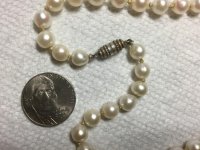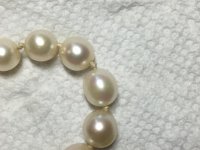Hello Pearl-Guide folks,
My mother passed away a few years ago, and I received most of her jewelry. Her death hit me hard and I have not looked at the jewelry much, but recently started thinking it would be nice to have a pearl choker, and I vaguely remembered some family pearls I had not seen in many years. They were in her jewelry box.
I remember being told that these pearls had been my great-grandmother's; certainly my grandmother wore them. She was born in 1915 or so, and came, I understand, from a fairly wealthy New York railroad family. I hope the pictures will be clear enough to give you an idea. I apologize for the paper towel backdrop...! They were taken with an iPad camera indoors, at night, using my full-spectrum desk lamp. I can try to get better shots if they are needed.
I'm also sorry I have so little info about their provenance. I can't even tell you what the barrel clasp is made of (Sterling?). Note that the rosy tones you see in the photo aren't as pronounced in real life; I actually wonder if the pearls picked up the color of my shirt. They are creamy in real life and look translucent in some lights, with overtones of pink and green. There are 49 pearls on this graduated strand, btw, which runs about 17 3/4" long.
No matter what they are, I love these guys to pieces, and I want to wear them as often as I can--both because I find them beautiful and because they remind me of beloved family members I won't see again in this life.
Thanks in advance for any light you can shed. I look forward to hearing from you. I have been reading threads on this forum for a few days, and have been really impressed by the knowledge here (and the wonderful, wonderful photos!).
Regards,
Julia
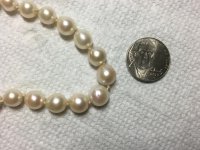
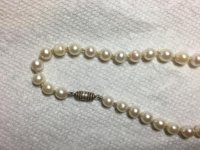
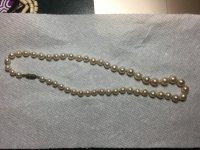
My mother passed away a few years ago, and I received most of her jewelry. Her death hit me hard and I have not looked at the jewelry much, but recently started thinking it would be nice to have a pearl choker, and I vaguely remembered some family pearls I had not seen in many years. They were in her jewelry box.
I remember being told that these pearls had been my great-grandmother's; certainly my grandmother wore them. She was born in 1915 or so, and came, I understand, from a fairly wealthy New York railroad family. I hope the pictures will be clear enough to give you an idea. I apologize for the paper towel backdrop...! They were taken with an iPad camera indoors, at night, using my full-spectrum desk lamp. I can try to get better shots if they are needed.
I'm also sorry I have so little info about their provenance. I can't even tell you what the barrel clasp is made of (Sterling?). Note that the rosy tones you see in the photo aren't as pronounced in real life; I actually wonder if the pearls picked up the color of my shirt. They are creamy in real life and look translucent in some lights, with overtones of pink and green. There are 49 pearls on this graduated strand, btw, which runs about 17 3/4" long.
No matter what they are, I love these guys to pieces, and I want to wear them as often as I can--both because I find them beautiful and because they remind me of beloved family members I won't see again in this life.
Thanks in advance for any light you can shed. I look forward to hearing from you. I have been reading threads on this forum for a few days, and have been really impressed by the knowledge here (and the wonderful, wonderful photos!).
Regards,
Julia



Attachments
Last edited:

